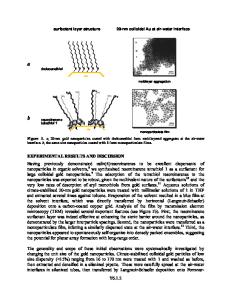A Thermogravimetric Study of Alakanethiolate Monolayer-Capped Gold Nanoparticle Catalysts
- PDF / 206,390 Bytes
- 6 Pages / 612 x 792 pts (letter) Page_size
- 15 Downloads / 324 Views
N10.4.1
A Thermogravimetric Study of Alakanethiolate Monolayer-Capped Gold Nanoparticle Catalysts Mathew M. Maye, Sandy Chen, Wai-Ben Chan, Lingyan Wang, Peter Njoki, I-Im. S. Lim, Jennifer Mitchell, Li Han, Jin Luo, and Chuan-Jian Zhong* Department of Chemistry, State University of New York at Binghamton, Binghamton, NY 13902. *[email protected] ABSTRACT The application of molecularly-capped gold nanoparticles (1-5 nm) in catalysis (e.g., electrocatalytic oxidation of CO and methanol) requires a thorough understanding of the surface composition and structural properties. Gold nanoparticles consisting of metallic or alloy cores and organic encapsulating shells serve as an intriguing model system. One of the challenges for the catalytic application is the ability to manipulate the core and the shell properties in controllable ways. There is a need to understand the relative core-shell composition and the ability to remove the shell component under thermal treatment conditions. In this paper, we report results of a thermogravimetric analysis of the alkanethiolate monolayer-capped gold nanoparticles. This investigation is aimed at enhancing our understanding of the relative core-shell composition and thermal profiles.
INTRODUCTION Catalysis plays a vital role in chemical processing, environmental protection and fuel cell technology. The use of gold nanoparticles as catalysts has attracted increasing interest recently [1-4], due to the pioneer work of Haruta [5] who demonstrated the high catalytic activities for CO and hydrocarbon oxidation at metal oxide supported gold nanoparticles of less than ~10 nm. We have recently shown that the preparation of nanoscale gold catalysts can be achieved using alkanethiolate monolayer-capped nanoparticles. These nanoparticles consist of metal or alloy nanocrystal cores with organic molecular wiring or linkage shells that aid to define the interparticle spatial property [6-8]. This approach to the nanoparticle preparation and processing is useful because it allows us to address many of the fundamental issues related to size, shape, aggregation, poisoning, and surface engineering of nanoparticles in catalysis (e.g., fuel cell catalysis). To exploit the catalytic properties of the core-shell type nanoparticles, we need to establish effective means to remove the organic shell while making the nanocrystal core’s morphological properties under control. The focus of this work is to assess the relative coreshell composition and thermal profile in thermal treatment of the core-shell gold nanoparticle catalysts using thermogravimetic analysis (TGA) technique. We studied Au nanoparticles of ~2 nm core sizes (Au2-nm) capped with decanethiol (DT). The results provide information for us to assess thermal activation parameters.
N10.4.2
EXPERIMENTAL Chemicals. Major chemicals included decanethiol, (DT, 96%), hydrogen tetracholoroaurate (HAuCl4, 99%), tetraoctylammonium bromide (TOABr, 99%), sodium borohydride (NaBH4, 99%), toluene (Tl, 99.8%), hexane (Hx, 99.9%), ethanol (EtOH) and methano
Data Loading...











